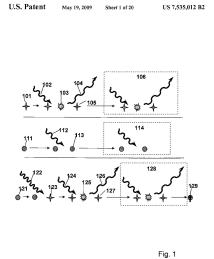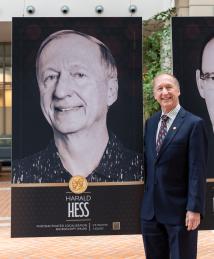Harald Hess
"Science should be doing things, not for being famous, but for really somehow doing something unique and useful."
Harald Hess and Eric Betzig co-invented photoactivated localization microscopy (PALM), a super-resolution imaging technology that enables imaging at the nanoscale, and allows scientists to study biological structures, processes and diseases with greater clarity.
Born in the rural Midwest, Hess has said that growing up in a small town in the 1960s taught him to be resourceful and creative. His mother, a medical technician, and his father, a doctor, gave him the freedom to follow his “inclinations and fascinations,” he explained in an interview with the National Inventors Hall of Fame®. This included many areas of physics, which he explored via science projects, with resources from local shops, junkyards, libraries and even medical supplies catalogs from his father.
Describing himself as “curiosity-driven,” Hess continued exploring into his college years. “I didn't want to commit too early going into college to a particular direction,” said Hess. “I opted to go to more of a liberal arts school and learn a little bit about history and economics without being committed to a particular field for a while.” His studies eventually led him to a bachelor’s degree in physics from the University of Chicago, followed by a doctorate in physics from Princeton University in 1982. He completed his postdoctoral research at the Massachusetts Institute of Technology.
While working at Bell Labs in the late 1980s, Hess began collaborating with his friend and fellow National Inventors Hall of Fame Inductee Betzig. “Eric and I had complementary interests and a very complementary set of expertise,” said Hess. “Put together, each was learning a little bit from the other.”
Hess worked on seeing quantum phenomenon at cryogenic temperatures such as individual magnetic flux lines or single electrons with various new forms of scanned probe microscopy, while Betzig explored the limits of optical resolution to see individual molecules with his microscope. They later combined their expertise to make a microscope that revealed the optical quantum states of a semiconductor, an experiment that set the stage for a breakthrough one decade later.
Hess immersed himself in the microscopy and technology challenges of the hard disk drive and semiconductor industries from 1998 until 2005, when he and Betzig decided to explore new research options together. On learning of new blinking fluorescent molecules, they quickly realized its implication for a much higher resolution microscope.
Hess and Betzig each invested $25,000 and got to work in Hess’ living room in September 2005. In just two months, they hand-built a prototype. Approximately the size of a soda can, the prototype used fluorescent proteins to differentiate individual molecules, surpassing the contemporary limitations of resolution in optical microscopy.
In 2005, Hess and Betzig’s microscope was used successfully for the first time, representing a foundational achievement in super resolution microscopy for life sciences. In 2007, the co-inventors signed a license agreement with Zeiss to commercialize PALM technology.
Hess holds 31 U.S. patents and his honors include the 2023 James Prize in Science and Technology Integration, awarded by the National Academy of Sciences. He currently serves as senior group leader at the Janelia Research Campus of the Howard Hughes Medical Institute. “Here at Janelia, we've expanded into a very large-scale 3D, trying to see things at electron microscope resolution, but almost at the 1-millimeter scale, and combining that with PALM or other microscopy modalities,” Hess said. “For me, it's still pretty exciting. It's a whole new world.”

